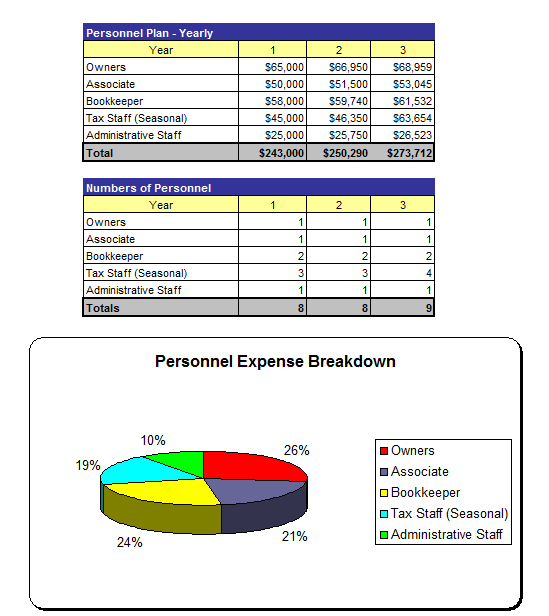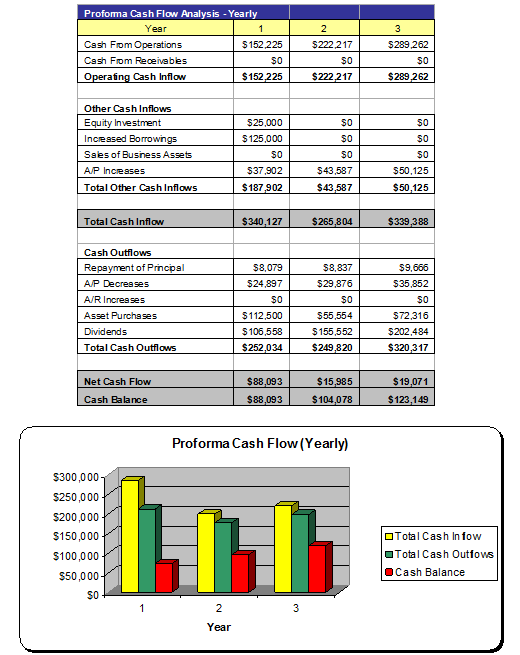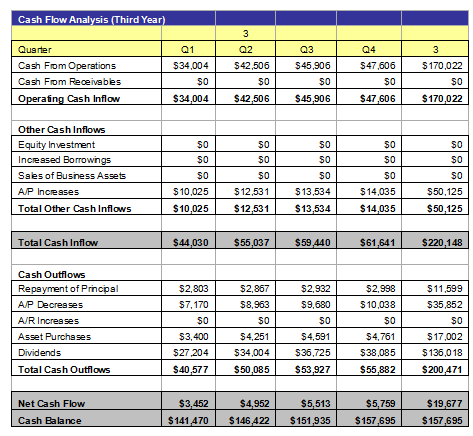Free Grocery Store Business Plan
For Raising Capital from Investors, Banks, or Grant Companies!
Please note that the financials
in this complete free business plan are completely fictitious and may not
match the text of the business plan below. This free business plan demonstration
purposes only. If you are interested in purchasing the completed editable MS Word
and Excel documents for this business plan, please click the button below! Also,
the text of the business plan is formatted with a fully automated
table of contents.
Return to
Samples Page
It should be noted that there is no special software required to use these
templates. All business plans come in Microsoft Word and Microsoft Excel format.
Each business plan features:
- Excecutive Summary
- Company and Financing Summary
- Products and Services Overview
- Strategic Analysis with current research!
- Marketing Plan
- Personnel Plan
- 3 Year Advanced Financial Plan
- Expanded Financial Plan with Monthly Financials
- Loan Amortization and ROI Tools
- FREE PowerPoint Presentation for Banks, Investors,
or Grant Companies!
1.0 Executive Summary
The purpose of this business plan is to raise $250,000 for the development of a grocery store while showcasing the expected financials and operations over the next three years. Grocery Store, Inc. (“the Company”) is a New York based corporation that will sell grocery items from its moderate sized retail location its customers in its targeted market. The Company was founded by John Doe.
1.1 Products and Services
Through the Grocery Store, the business will offer the general public a number of products that are found throughout supermarkets. The business will carry thousands of items across many brand names. The business will maintain the following divisions within the market: • General Grocery • Deli and Packaged Meats • Produce • General Merchandise • Specialty food kiosks The third section of the business plan will further describe the services offered by the Grocery Store.
1.2 The Financing
Mr. Doe is seeking to raise $250,000 from as a bank loan. The interest rate and loan agreement are to be further discussed during negotiation. This business plan assumes that the business will receive a 10 year loan with a 9% fixed interest rate. The financing will be used for the following: • Development of the Company’s Grocery location. • Financing for the first six months of operation. • Capital to purchase the Company’s inventory. Mr. Doe will contribute $50,000 to the venture.
1.3 Mission Statement
The Grocery Store’s mission is to become the recognized leader in its targeted market for providing grocery items at a reasonable cost.
1.4 Mangement Team
The Company was founded by John Doe. Mr. Doe has more than 10 years of experience in the retail management industry. Through his expertise, he will be able to bring the operations of the business to profitability within its first year of operations.
1.5 Sales Forecasts
Mr. Doe expects a strong rate of growth at the start of operations. Below are the expected financials over the next three years.

1.6 Expansion Plan
The Founder expects that the business will aggressively expand during the first three years of operation. Mr. Doe intends to implement marketing campaigns that will effectively target individuals within the target market.
2.0 Company and Financing Summary
2.1 Registered Name and Corporate Structure
Grocery Store, Inc. The Company is registered as a corporation in the State of New York.
2.2 Required Funds
At this time, the Grocery Store requires $250,000 of debt funds. Below is a breakdown of how these funds will be used:

2.3 Investor Equity
Mr. Doe is not seeking an investment from a third party at this time.
2.4 Management Equity
John Doe owns 100% of the Grocery Store, Inc.
2.5 Exit Strategy
If the business is very successful, Mr. Doe may seek to sell the business to a third party for a significant earnings multiple. Most likely, the Company will hire a qualified business broker to sell the business on behalf of the Grocery Store. Based on historical numbers, the business could fetch a sales premium of up to 4 times earnings.
3.0 Products and Services
3.1 General Grocery
The primary business unit of the Grocery Store will be the general grocery section, where the business will feature a number of prepackaged products including cereals, breads, pastas, cookies/candies, pet food suppliers, ethnic foods, and a number of other staple goods. The business will carry these products under several brand names and from the direct purchase of local suppliers and vendors.
3.2 Packaged and Deli Meats
The business will also maintain an extensive deli that will serve a variety of beef, pork, and seafood products. The business will always have a butcher on staff, and all meat (both fresh and packaged) will meet all regulations regarding the sale of meat products. Management expects that sales of deli and packaged meat products will account for almost 20% of the Company’s transactions.
4.0 Strategic and Market Analysis
4.1 Economic Outlook
This section of the analysis will detail the economic climate, the grocery Store industry, the customer profile, and the competition that the business will face as it progresses through its business operations. Currently, the economic market condition in the United States is moderate. The meltdown of the sub prime mortgage market coupled with increasing gas prices has led many people to believe that the US is on the cusp of a double dip economic recession. This slowdown in the economy has also greatly impacted real estate sales, which has halted to historical lows. However, grocery stores tend to operate with great economic stability as people will continue to purchase grocery goods in any economic climate.
4.2 Industry Analysis
Within the United States, three are approximately 95,000 grocery stores in operation. Each year, these businesses aggregately generate more than $500 billion of revenues while providing jobs for more than 2.9 million people. In each of the last five years, annual payrolls have exceeded $50 billion. This is a mature industry, and the anticipated future growth rate will remain in line with that of the general economy.
4.3 Customer Profile
The Company expects that the average customer of the Grocery Store will have the following demographics: • Household/family income of $25,000 to $75,000 per year (in US Dollars) or less. • Has a family of four or five people. • Will regularly use the Company’s store once a quality rapport has been developed. Through these demographics, the Company will structure its advertising and marketing campaigns to appeal to the above demographics.
4.4 Competitive Analysis
This is one of the sections of the business plan that you must write completely on your own. The key to writing a strong competitive analysis is that you do your research on the local competition. Find out who your competitors are by searching online directories and searching in your local Yellow Pages. If there are a number of competitors in the same industry (meaning that it is not feasible to describe each one) then showcase the number of businesses that compete with you, and why your business will provide customers with service/products that are of better quality or less expensive than your competition.
5.0 Marketing Plan
The Grocery Store intends to maintain an extensive marketing campaign that will ensure maximum visibility for the business in its targeted market. Below is an overview of the marketing strategies and objectives of the Company.
5.1 Marketing Objectives
-
• Establish relationships with wholesalers within the regional market.
-
• Implement a local campaign with the Company’s targeted market via the use of flyers, local newspaper advertisements, and word of mouth advertising.
-
• Develop an online presence by developing a website and placing the Company’s name and contact information with online directories.
5.2 Marketing Strategies
Retail marketing will be the most difficult portion of the marketing strategy. This is because one of the essential elements to reaching a retail audience is that the Company must build a brand affinity with the customer. Management fully expects to enlist the help of a local marketing firm to reach the Company's targeted consumer. The grocery store industry is an extremely competitive market, and as such, the Management of Grocery Store, Inc. will need to develop a marketing program that creates a branded image edge over its competition. The Company will maintain a moderate level of traditional print and media advertising, which will be exclusively geared towards the Grocery Store’s consumer. These traditional advertisements include billboards and distribution of flyers/circulars in controlled circulation publications. This will ensure that the target audience is continually aware of Grocery Store’s grand openings and regular discount promotions. Finally, the business will develop a small online platform (registered with several online directories) so that people can easily find the Company’s location by searching (via sites like Google, Yahoo, etc.) for grocery stores.
5.3 Pricing
In this section, describe the pricing of your services and products. You should provide as much information as possible about your pricing as possible in this section. However, if you have hundreds of items, condense your product list categorically. This section of the business plan should not span more than 1 page.
6.0 Organizational Plan and Personnel Summary
6.1 Corporate Organization

6.2 Organizational Budget

6.3 Management Biographies
In this section of the business plan, you should write a two to four paragraph biography
about your work experience, your education, and your skill set. For each owner or
key employee, you should provide a brief biography in this section.
7.0 Financial Plan
7.1 Underlying Assumptions
-
• Grocery Store, Inc. will have an annual revenue growth rate of 7% per year.
-
• The Owner will acquire $250,000 of debt funds to develop the business.
-
• The loan will have a 10 year term with a 9% interest rate.
7.2 Sensitivity Analysis
The Company’s revenues are not sensitive to changes in the general economy. People demand certain grocery store items as a necessity, and the business only expects that an economic catastrophe could result in decreases in revenue. The Company’s programs for general merchandise will ensure that Grocery Store, Inc. continues to thrive despite deleterious changes in the general economy.
7.3 Source of Funds

7.4 General Assumptions

7.5 Profit and Loss Statements

7.6 Cash Flow Analysis

7.7 Balance Sheet
 .
.
7.8 General Assumptions

7.9 Business Ratios

Expanded Profit and Loss Statements




Expanded Cash Flow Analysis



